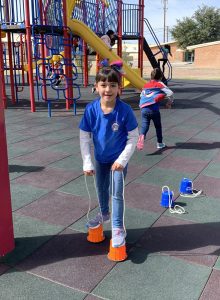Ways to Prevent Summer Physical Activity Loss
 You’ve no doubt heard about “summer learning loss” (or “summer slide”), the phenomenon where kids’ academic performance and knowledge is lower in the fall than it was when they left school the previous spring.
You’ve no doubt heard about “summer learning loss” (or “summer slide”), the phenomenon where kids’ academic performance and knowledge is lower in the fall than it was when they left school the previous spring.
Did you know that the same situation exists for physical activity? Although there is no catchy name, studies show that cardiovascular performance declines and overweight and obesity increase after summer break. Given that kids in the U.S. already don’t get enough physical activity during the year (the recommended daily amount is 60 minutes), this means that they are especially sedentary during the summer. Without school all day long, families may be more reliant on screen time and have fewer scheduled activities, such as sports and clubs.
Unfortunately, both types of summer loss are much greater for children of color and children from underserved communities due to limited access to resources such as camps, park programs, classes, travel, and safe places to play.
It’s important for both schools and parents/caregivers to prepare for this summer loss and ensure kids have ways to stay active while out of school. Some ways to make this happen include:
- Creating a list of activities (make sure many are easy, free, and/or doable at home) to pull from when you need inspiration. They can even be randomly drawn from a jar or bowl to make the surprise more fun for kids. Use household objects in new ways to put a spin on classic activities. Check out our Game On activity library for some ideas.
- Developing routines, which are good for physical and emotional health because they help you feel grounded and in control. Work with your kids or students to come up with some physical activity routines that interest them, such as doing stretching and yoga each morning or shooting hoops a few afternoons per week.
- Limiting or making the most of screen time. By restricting screen time to only certain rooms of the home or certain times/days of the week, among other strategies, kids will be more likely to partake in physical activities. Another idea is to turn screen time itself into an opportunity for physical activity. See ways to make that happen.
- Tying movement to emotional health by encouraging creative expression. Activities like dancing, imaginative play, and outdoor exploration not only generate physical activity, but they also help kids develop critical social emotional skills.
- Ensuring kids have access to equipment and space. Millions of families do not have things like jump ropes, balls, or a yard. Work with your school, neighborhood, or city to keep places such as school gymnasiums and playgrounds open for use during certain hours all summer. Schools can help make families aware of community programs and organizations that have free or low-cost summer activities for kids.
Categories: Health at Home, Making Change Happen, Physical Activity, PE, & Play